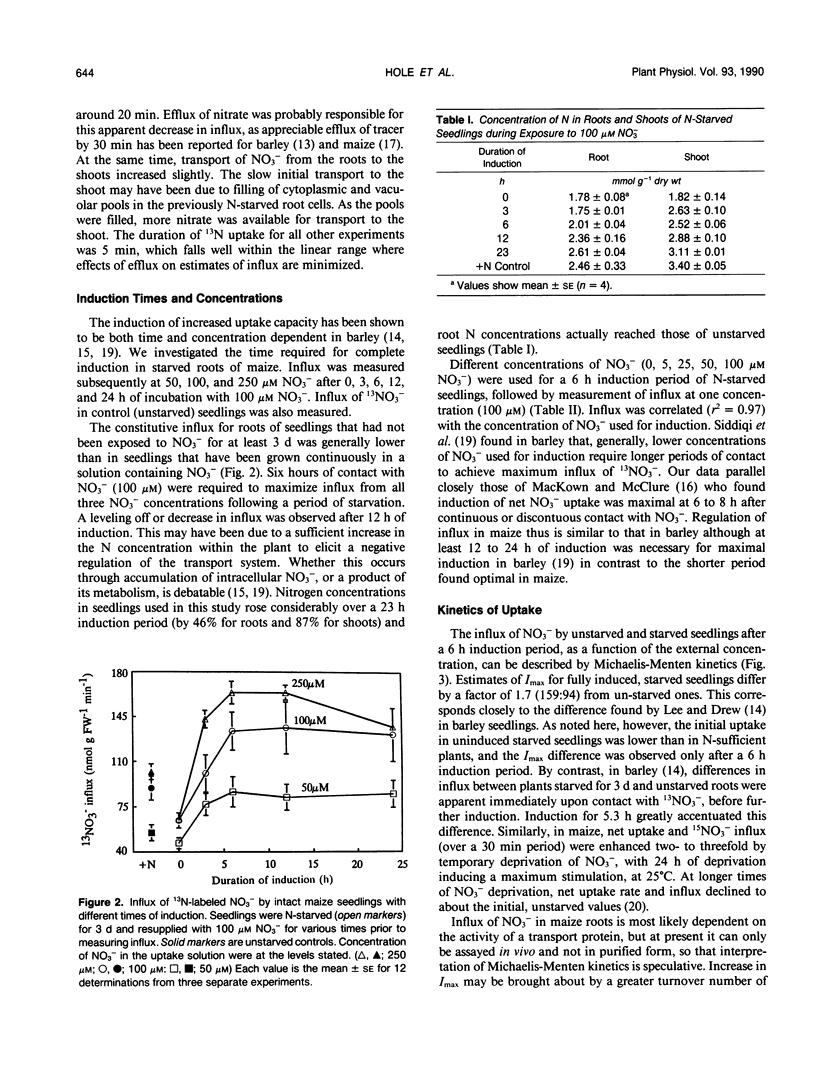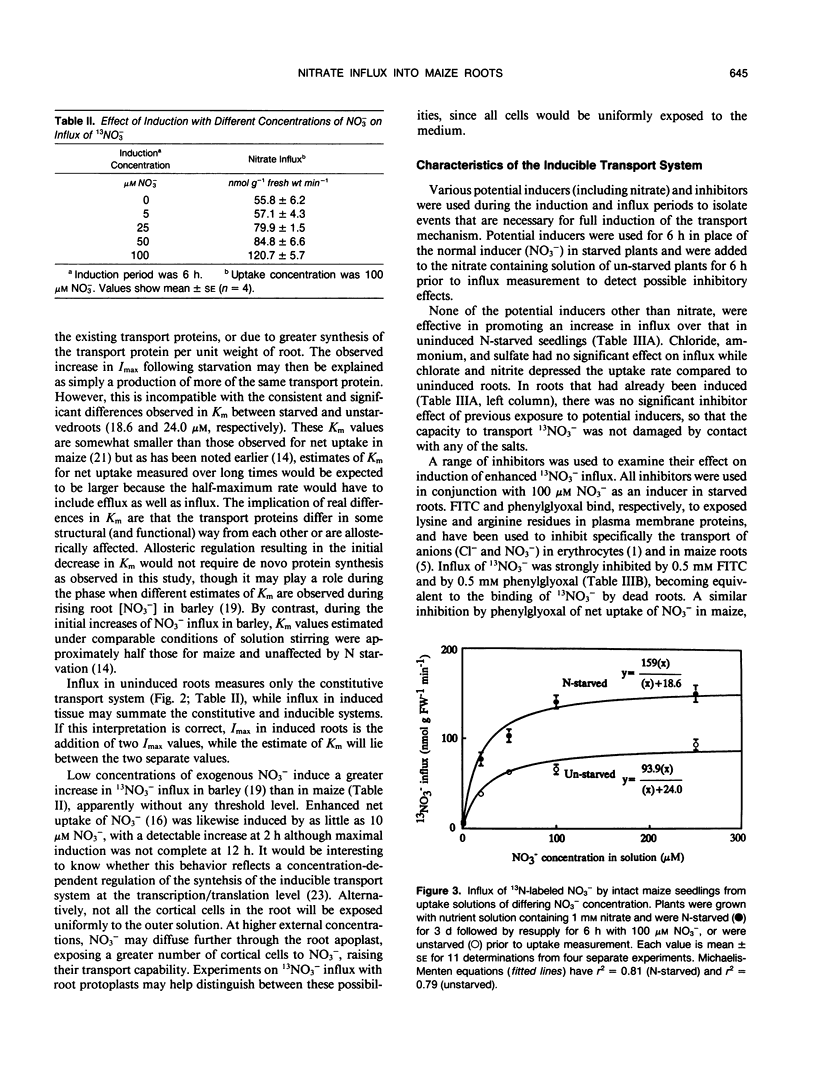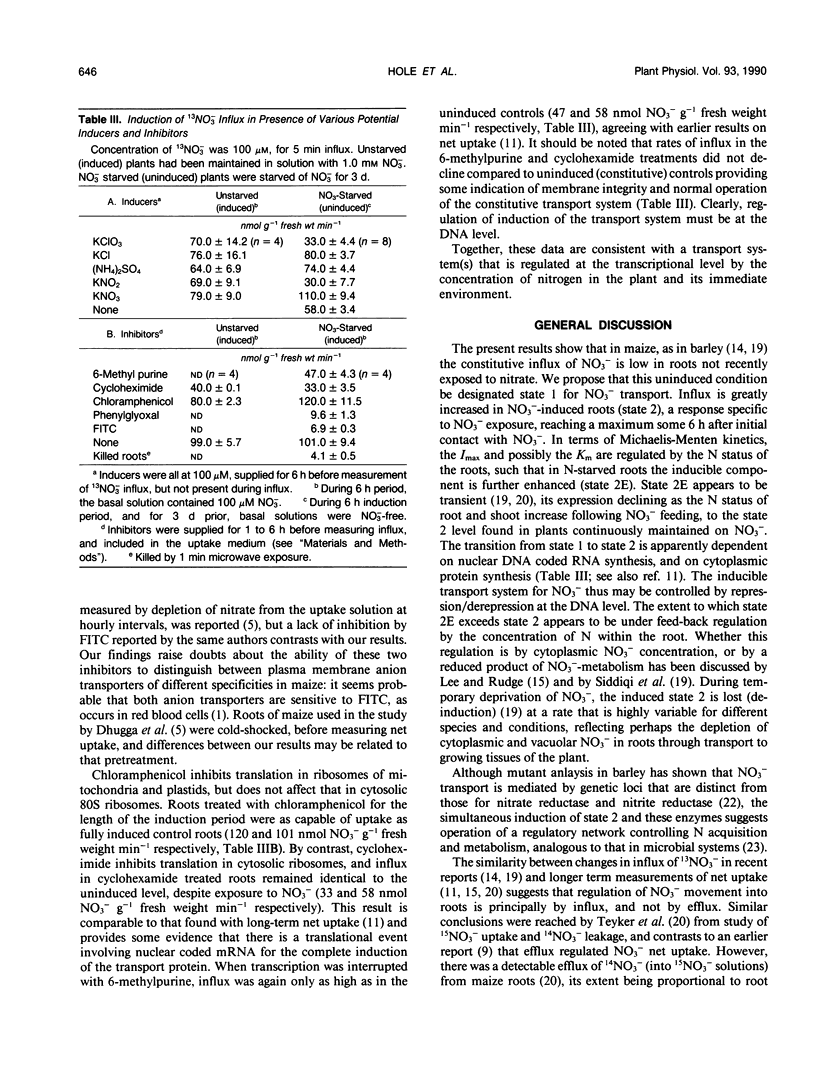Abstract
Unlike phosphate or potassium transport, uptake of nitrate by roots is induced, in part, by contact with the substrate ion. Plasmalemma influx of 13N-labeled nitrate in maize roots was studied in relation to induction of the uptake system, and the influence of short-term N starvation. Maize (Zea mays) roots not previously exposed to nitrate had a constitutive transport system (state 1), but influx increased 250% during six hours of contact with 100 micromolar nitrate, by which time the transport mechanism appeared to be fully synthesized (state 2). A three-day period of N starvation prior to induction and measurement of nitrate influx resulted in a greater capacity to transport nitrate than in unstarved controls, but this was fully expressed only if roots were kept in contact with nitrate for the six hours needed for full induction (state 2E). A kinetic analysis indicated a 160% increase in maximum influx in N-starved, induced roots with a small decrease in Km. The inducible component to nitrate influx was induced only by contact with nitrate. Full expression of the nitrate inducible transport system was dependent upon mRNA synthesis. An inhibitor of cytoplasmic protein synthesis (cycloheximide) eliminated the formation of the transport system while inhibition by chloramphenicol of mitochondrial- or plastid-coded protein synthesis had no effect. Poisoning of membrane-bound proteins effectively disabled both the constitutive and induced transport systems.
Full text
PDF





Selected References
These references are in PubMed. This may not be the complete list of references from this article.
- Bjerrum P. J., Wieth J. O., Borders C. L., Jr Selective phenylglyoxalation of functionally essential arginyl residues in the erythrocyte anion transport protein. J Gen Physiol. 1983 Apr;81(4):453–484. doi: 10.1085/jgp.81.4.453. [DOI] [PMC free article] [PubMed] [Google Scholar]
- Dhugga K. S., Waines J. G., Leonard R. T. Correlated induction of nitrate uptake and membrane polypeptides in corn roots. Plant Physiol. 1988 May;87(1):120–125. doi: 10.1104/pp.87.1.120. [DOI] [PMC free article] [PubMed] [Google Scholar]
- Dhugga K. S., Waines J. G., Leonard R. T. Nitrate absorption by corn roots : inhibition by phenylglyoxal. Plant Physiol. 1988 Mar;86(3):759–763. doi: 10.1104/pp.86.3.759. [DOI] [PMC free article] [PubMed] [Google Scholar]
- Glass A. D., Thompson R. G., Bordeleau L. Regulation of NO(3) Influx in Barley : Studies Using NO(3). Plant Physiol. 1985 Feb;77(2):379–381. doi: 10.1104/pp.77.2.379. [DOI] [PMC free article] [PubMed] [Google Scholar]
- Jackson W. A., Flesher D., Hageman R. H. Nitrate Uptake by Dark-grown Corn Seedlings: Some Characteristics of Apparent Induction. Plant Physiol. 1973 Jan;51(1):120–127. doi: 10.1104/pp.51.1.120. [DOI] [PMC free article] [PubMed] [Google Scholar]
- Mackown C. T., McClure P. R. Development of accelerated net nitrate uptake : effects of nitrate concentration and exposure time. Plant Physiol. 1988 May;87(1):162–166. doi: 10.1104/pp.87.1.162. [DOI] [PMC free article] [PubMed] [Google Scholar]
- Siddiqi M. Y., Glass A. D., Ruth T. J., Fernando M. Studies of the Regulation of Nitrate Influx by Barley Seedlings Using NO(3). Plant Physiol. 1989 Jul;90(3):806–813. doi: 10.1104/pp.90.3.806. [DOI] [PMC free article] [PubMed] [Google Scholar]
- Teyker R. H., Jackson W. A., Volk R. J., Moll R. H. Exogenous NO(3) Influx and Endogenous NO(3) Efflux by Two Maize (Zea mays L.) Inbreds during Nitrogen Deprivation. Plant Physiol. 1988 Mar;86(3):778–781. doi: 10.1104/pp.86.3.778. [DOI] [PMC free article] [PubMed] [Google Scholar]
- Warner R. L., Huffaker R. C. Nitrate transport is independent of NADH and NAD(P)H nitrate reductases in barley seedlings. Plant Physiol. 1989;91:947–953. doi: 10.1104/pp.91.3.947. [DOI] [PMC free article] [PubMed] [Google Scholar]


